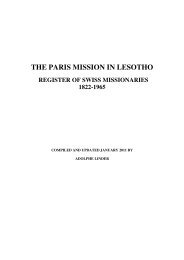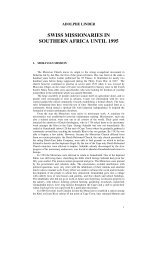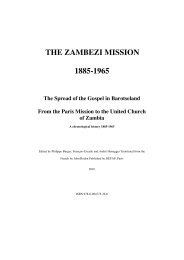THE SWISS IN SOUTHERN AFRICA 1652-1970 - swissroots-za.ch
THE SWISS IN SOUTHERN AFRICA 1652-1970 - swissroots-za.ch
THE SWISS IN SOUTHERN AFRICA 1652-1970 - swissroots-za.ch
You also want an ePaper? Increase the reach of your titles
YUMPU automatically turns print PDFs into web optimized ePapers that Google loves.
All the lieutenants and junior officers of the regiment together formed the court. They<br />
heard the case and decided on the appropriate sentences whi<strong>ch</strong> were submitted for<br />
approval to the commanding officer Count de Meuron and his senior officers assembled<br />
in the Castle. Sentence was then pronounced to the waiting prisoners and the regiment,<br />
and immediately carried out on the nearby place of execution. The principal culprit was<br />
hanged, the others scourged, branded and banned to Robben Island for various numbers<br />
of years, there to be put in <strong>ch</strong>ains and labour in the quarries.<br />
De Meuron was severely criticised for the harsh sentences passed, but he replied that<br />
the Swiss knew and respected their old laws and that these were very necessary for<br />
maintaining discipline under sometimes very difficult circumstances.<br />
The Regiment is transfered to Ceylon.<br />
By 1786 the effective membership of the regiment had diminished to su<strong>ch</strong> an extent<br />
that the Company decided to transfer it to Ceylon. The officers were given the option to<br />
resign, whi<strong>ch</strong> quite a number did. The Regiment Württemberg arrived at the Cape in<br />
1787 to replace the Swiss and by 1788 the Regiment Meuron had left leaving only a<br />
depot manned by a captain, sergeants and fifty soldiers.<br />
After the regiment had departed from the Cape, officers passing on their way to and<br />
from Ceylon spent pleasant days with compatriots living here. Notable amongst these<br />
were Susanna Margaretha Nicolet of Lignerolle NE, wife of Colonel Robert Gordon,<br />
officer commanding the Dut<strong>ch</strong> forces at the Cape. and her former maid and companion<br />
Anne Albertine Bienvignon of Vufflens-la-Ville VD, married to Jan Christiaan Yselle<br />
of Hasle BE, who provided board and lodging.<br />
A few officers married Cape Town girls who left with them for Ceylon. Some officers<br />
resigned from the regiment in order to settle here. Of these the most prominent Swiss<br />
and the only one whose name lives on in South Africa was Jean-Charles de la Harpe. He<br />
became a successful businessman and farmer, owning at various times farms at<br />
Wynberg, near Elgin, near Mossel Bay where he built a mansion whi<strong>ch</strong> was recently<br />
declared a National Monument but shortly after was destroyed by fire, and at<br />
Plettenberg Bay. The only surviving historical monument is the funeral hat<strong>ch</strong>ment in<br />
the Grootkerk, Cape Town, to commemorate Andre-Urbain de le Nieps Henry of Nyon<br />
VD, Officer Commanding the Regimental Depot.<br />
Two of the Regiment’s officers, Baron de Bonstetten of Berne and Simon de Sandol-<br />
Roy of Canton Neu<strong>ch</strong>atel served the Dut<strong>ch</strong> for a short period as Captains of the<br />
Recruits. Simon Henry de le Nieps Prevost of Nynon VD, after resigning from the<br />
regiment and successfully applying to the Company for a military appointment,<br />
departed for Europe but returned to the Cape in 1803 now known as Colonel Henry, as<br />
Commander and Chief of the Batavian troops.<br />
/ 1 Linder, A.: The Swiss Regiment Meuron at the Cape and afterwards, 1781-1816; 2<br />
KAB, VC 33, Journal, 7.2.1783; 3 KAB, VC 34, Journal, 29.8.1785; 4 KAB, BO 237.<br />
Members of the Regiment in action defending the Cape, 1795.<br />
On 11 June 1795 a British task force of nine vessels appeared in False Bay on a<br />
mission to seize the Cape. The Cape government was not sure whether they were hostile<br />
or not. Further confusion arose when the British produced a letter from Prince William V<br />
of Orange, in whi<strong>ch</strong> he asked the Cape Government to accept the British as friends and<br />
protectors. The Cape was starved of news. Rumours spread that the Prince of Orange<br />
was in England, that the Fren<strong>ch</strong> had occupied the Netherlands and that the Dut<strong>ch</strong><br />
revolutionaries had formed a new government. The attitude of the Cape government<br />
toward the British forces who had clearly arrived to take possession of the Cape, was<br />
ambivalent. Opinion was split beween those who favoured the Prince and those who<br />
favoured the new government in Holland.<br />
The garrison at Simon’s Town comprised 60 infantry men and 80 gunners. Colonel<br />
De Lille immediately sent an additional 120 infantrymen and 80 gunners and signal guns<br />
were fired throughout the colony to call up the burgher commandos. Yet at the same time<br />
the British were allowed fresh supplies, could place their sick in the hospital at Simon’s<br />
Town, and every day a limited number of sailors and soldiers were allowed ashore to<br />
28







